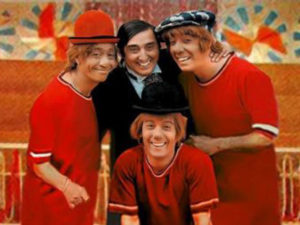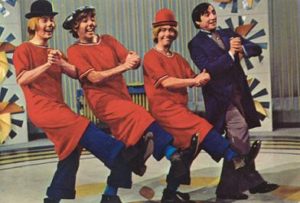 TRES FAMOSOS PAYASOS ESPAÑOLES QUE AMARON A CUBA: GABY, FOFO Y MILIKI.
TRES FAMOSOS PAYASOS ESPAÑOLES QUE AMARON A CUBA: GABY, FOFO Y MILIKI.
Fué con la muerte de Emilio Aragón Bermúdez “Miliki” en 2012 que desapareció el último heredero de una larga tradición familiar circense, que se remonta al siglo XIX. Estos tres hermanos dedicados tambien al circo , eran hijos de Emilio Aragón Foureaux y sobrinos de José María y Teodoro Aragón Foureaux (estos formarían el grupo cómico Emig, Pompoff y Thedy). Otros miembros de la familia también se dedicaron al mundo del circo.
“Gaby, Fofó y Miliki” comenzaron sus actuaciones en España en el año 1939 en el Circo Price. En 1946 los tres hermanos emigraron a América, donde permanecerían más de un cuarto de siglo. Se instalaron en Cuba, donde hicieron sus primeras incursiones en el mundo de la televisión a partir de 1949. En los años siguientes, la difusión de sus programas por otros países de Latinoamérica los convierte en rostros conocidos en México, Venezuela, Puerto Rico o Estados Unidos.
Fue en noviembre de 1946, tras la muerte de su padre que deciden irse a Cuba, embarcando en Cádiz para un contrato de cuatro meses que se convierten en 27 años de estancia en América.
En ese mismo año actúan en los principales locales de La Habana, como el Tropicana y tienen un espacio en la radio: “Radio Circo”. Después van en México, donde participan en la película “El nieto del Zorro”, en la que Gaby interpreta al legendario personaje mexicano y Fofó y Miliki a sus dos hombres de confianza.
https://youtu.be/l8UmmPK6J8w
Vuelven a Cuba en 1949, cuando se inaugura la televisión, la primera del mundo en habla hispana. Organizan “El Tele Circo”. Durante un año y medio de actuaciones en Unión Radio TV de La Habana, consiguen ser líderes de audiencia. Su carácter pionero de payasos televisivos ya está asentado.
“Miliki” era hijo de Emilio Aragón Foureaux y de la bailarina, acróbata sobre caballo, Rocío Bermúdez, nacida en Carmona, Sevilla. Durante su estancia en Cuba se casará con una cubana y tendrá a sus hijos Rita, Pili y Emilio.
Según algunas biografías, en Cuba ruedan “La vida de los payasos” (1951). Luego pasan a la emisora CMQ TV en la que actúan durante nueve años, con el título “Aventuras de Gaby, Fofó y Miliki”, adquiriendo la ciudadanía cubana, como se afirma en “El libro de oro de la televisión”, editado en Cuba en 1954. Otro de sus programas allí fue “El circo de Valencia”.
En 1958 vuelven a actuar en el famoso cabaret Tropicana de La Habana. Poco después de 1959 la familia abandona la isla, después de 13 años de estancia (1946-1959). Allí queda el local de la pastelería que había abierto Miliki, en el barrio del Vedado. Y también nos queda, a los que tuvimos la oportunidad de verlos, el recuerdo de estos payasos que tanta alegría y buenos momentos nos dieron a las familias cubanas.
Hoy recordando a estos destacados artistas y parafraseando la pregunta con que siempre comenzaban sus espectáculos podríamos decir:
…¿Cómo están ustedes? … Tristes.
 THREE FAMOUS SPANISH CLOWNS WHO LOVED CUBA: GABY, FOFO, AND MILIKI.
THREE FAMOUS SPANISH CLOWNS WHO LOVED CUBA: GABY, FOFO, AND MILIKI.
It was with the death of Emilio Aragón Bermudez “Miliki” in 2012 that the last heir of a long circus family tradition disappeared, dating back to the 19th century. These three brothers also dedicated to the circus, were children of Emilio Aragón Foureaux and nephews of José María and Teodoro Aragón Foureaux (these would form the comic group Emig, Pompoff and Thedy). Other family members also dedicated themselves to the circus world.
Gaby, Fofó and Miliki began their performances in Spain in 1939 at the Circus Price. In 1946 the three brothers emigrated to America, where they would remain more than a quarter of a century. They settled in Cuba, where they made their first forays into the world of television since 1949. In the following years, the diffusion of their programs in other Latin American countries makes them familiar faces in Mexico, Venezuela, Puerto Rico or States United.
It was in November 1946, after the death of his father who decided to go to Cuba, embarking in Cádiz for a four-month contract that became 27 years of stay in America.
In the same year, they perform in the main venues in Havana, such as Tropicana and have a space on the radio: “Radio Circus”. Then they go to Mexico, where they participate in the movie “The Grandson of Zorro”, in which Gaby plays the legendary Mexican character and Fofó and Miliki to his two trusted men.
They return to Cuba in 1949, when the television is inaugurated, the first in the world in Spanish. They organize “The Tele Circus”. For a year and a half of performances on Unión Radio TV in Havana, they manage to be audience leaders. His pioneer character of television clowns is already settled.
“Miliki” was the son of Emilio Aragón Foureaux and the dancer, acrobat on a horse, Rocío Bermúdez, born in Carmona, Seville. During his stay in Cuba, he will marry a Cuban woman and will have his children Rita, Pili, and Emilio.
According to some biographies, in Cuba, they roll “The Life of the Clowns” (1951). Then they go to the CMQ TV station in which they perform for nine years, with the title “Adventures of Gaby, Fofó, and Miliki”, acquiring Cuban citizenship, as stated in “The Golden Book of Television”, published in Cuba in 1954. Another of his programs there was “The circus of Valencia”.
In 1958 they return to action in the famous Tropicana cabaret in Havana. Shortly after 1959, the family leaves the island, after 13 years of stay (1946-1959). There is the bakery shop that Miliki had opened in the Vedado neighborhood. And we also have the opportunity to see them, the memory of these clowns that gave us so much joy and good times to Cuban families.
And paraphrasing the question with which they always began their shows we could say:
…How are you? … sad.
Agencies/ Memorias Cubanas/ Internet Photos/ YouTube/ Arnoldo Varona/ www.TheCubanHistory.com
THE CUBAN HISTORY, HOLLYWOOD.









